4. History of European colonization: chapter 4: Asia
1/27
Earn XP
Description and Tags
1. British India 2. Southeast Asia (dutch east-indies + british colonies) 3. French Indochina 4. China
Name | Mastery | Learn | Test | Matching | Spaced |
|---|
No study sessions yet.
28 Terms
map british india 1819
they penetrated into inland India
light grey and dark grey = different

map british india 1857
further expansion of the Brits
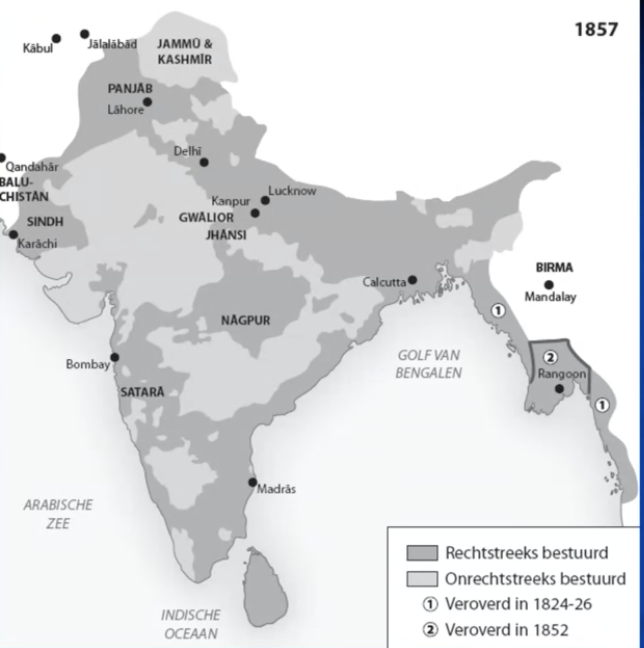
the ‘great game’
Russia and Britain: two victors of Napoleon => “cold war” (+some real wars)
british perceived russian threat
potentiality central asia (stan-countries) = threat to british India
indian march of tsar paul I (1801, to aral sea, with french) = british saw this as proof of threat
russian victories on persia (1813, 1826) = growing territorial expansion in caucasus
imaginary character (despite real threat) =
arthur conolly: coined name ‘great game’ in 1830s
Rudyard Kipling: popularized idea of ‘great game’
popularity due to (highlighted) ideological contrasts
UK: democracy, freedom, modernity (presented itself)
Russia: autocracy, militarism, serfdom (UK contrasted itself)
==> felt strongly about great game because they believed these ideals would take over
further british expansion
the first afghan war (1839-42) = disaster
1839: conquest of Qandahar & Kabul
1842: retreat following permanent insurrections (successful in conquering but not controlling)
the conquest of the sindth (1842-43, present day pakistan)
general Napier => not official policy of london or east-india company but allegedly done by individual soldiers (while british “were asleep”)
expansion happened through war
the conquest of Punjab (current-day pakistan and India)
Sikhism: 16th c, militarization in 17th c (vs Moghuls) = sikhs had their own army
1799-1839: mighty sikh kingdom of ranjit singh (lion of Punjab) = so strong that brits avoided conflict
1845-46 & 1848-49: first and second punjab war = brits conquered whole of Punjab
integration and modernization after annexation (=> less than 10 years later sikhs sided with brits during insurrection)
sikhism
16th century
guru in Punjab
Islam and Hinduism
reasons temporary break british and Russian expansion
british india: the insurrection of 1857-58
“the great mutiny”: started with mutiny indian soldiers british army => grew to largest anti-colonial insurrection in history of European colonization => In india = first war of independence
Major general henry havelock
1858: company rule —> crown rule (prevent future rebellion, no longer ruled by east-india company)
Russia: the Crimean War (1854-56)
France, Britain, allies helped ottomans fight of russian empire
==> new russian conquests from the 1860S
1858 and 1860: far east (khabarovsk & vladivostok)
1860S & 1870S: central Asia
==> revived British imperialism in the 1870s
ex. Queen victoria empress of India (1876)
new british expansion after break in 1850s
1876: british conquest of baluchistan
1877: East turkistan (present-day Xinjiang) to china
mutual disturst London and Saint-Petersburg
1878-1880: second afghan war
second British defeat in afghanistan
Tibet
1895: dalai lama starts pro-russian policy => alarms the brits
1905: british expedition and conquest of Lhasa
treaty between Tibet and Britain on free trade and borders (borders between present-day India and China) => today China still does not recognize borders
1906: China recognized as sovereign of Tibet (by London and SPB)
1911: independent theocracy after collapse of Chinese empire
1950s: re-conquest by Mao
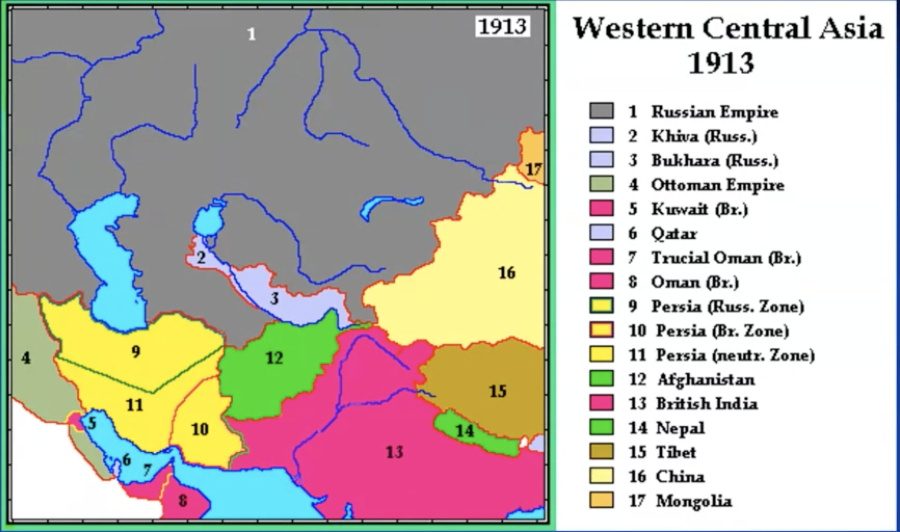
end of the great game
Why?
decline of Russia
defeated in Russo-Japanese War of 1904-1905 (remarkable)
rise of Germany (brits realized they should change enemy)
how?
1907: alliance between London and SPB, following
franco-russian alliance of 1892
entente cordiale (alliance) between france and Britain 1904
=> triple entente (first world war!)
division of persia in spheres of influence
central part independent
the Anglo-Burmese War
Burma conquered in 3 subsequent wars in 19th c
initially part of British India but separated in 1930s => now separate country
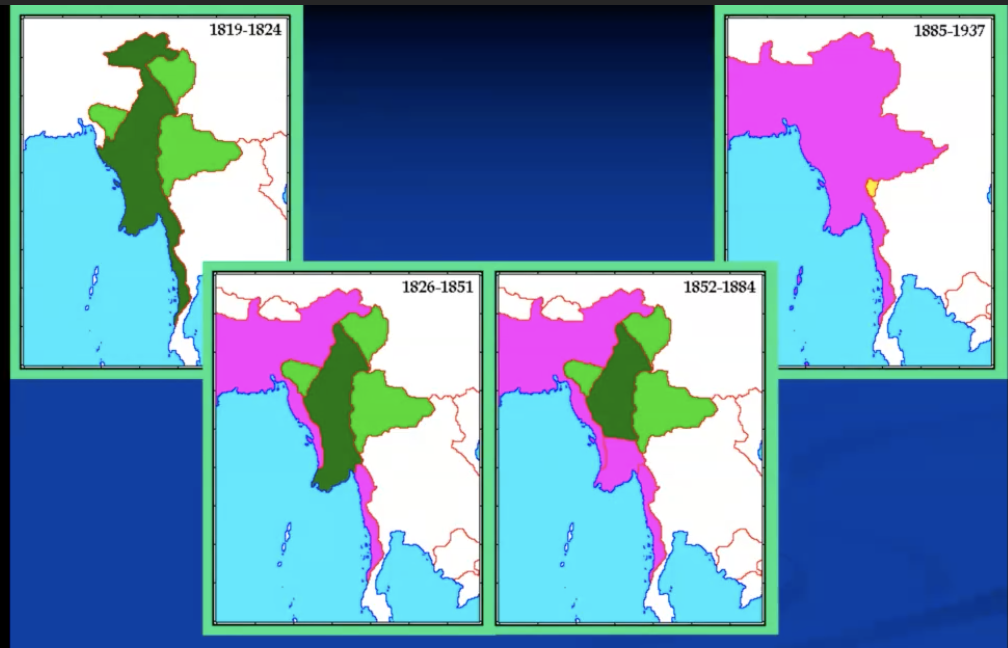
map territorial expansion of dutch in east-indies
conquered indonesia very gradually
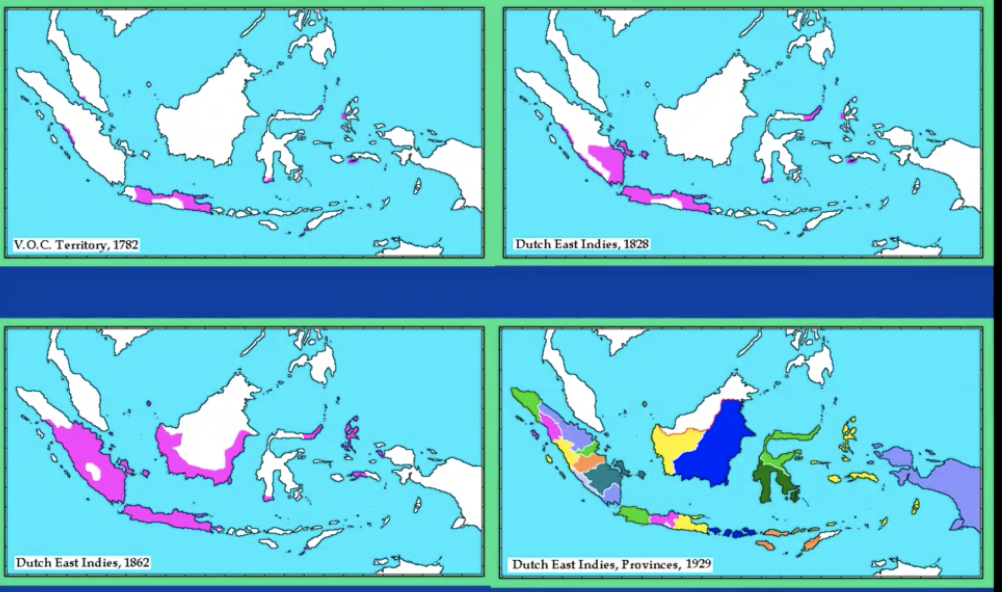
the collapse of the VOC
gradual decline of VOC (18th century) = Brits becoming more important
VOC in growing debt
Vergaan Onder Corruptie: perish by corruption
1780-1784: fourth anglo-dutch war (100 years after the others)
following dutch support of american rebels
dutch defeat but limited losses to britain
end of the dutch monopoly in south-east asia
1794-1806: Batavian republic (puppet state of France)
complicates link between Amsterdam and java
1796/9: bankrupcy VOC
1800: Dutch government takes over VOC propriety
the british in south east asia
Dutch kingdom under Louis Napoleon = weakened
1811-1815: dutch east indies occupied by britain
Thomas Raffles
1814 & 1824: convention and treaty of london
Java & Sumatra to the Dutch (strong buffer against france)
other colonies to the british (ex India and North Borneo(malaysia and Indonesia)) => netherlands lost position in south east asia
the malaysian peninsula = key importance because controls important trade route through strait
first: separate settlements
1786: penang (nowadays holiday resort, still british colonial architecture), 1819: singapore (raffles), 1824: Malacca (buildings by Portuguese)
1826: straits settlements
1867: crown colony
particularities dutch expansion in the dutch indies
much resistance
against taxes, coolies, interference,…
Islam as a factor of opposition and mobilization
a lot of wars, violence
gradual expansion
different wars ex Java (central area island) (1825-1830)
Diponegoro
Java surrendered
Aceh (1873-1908)
NW sumatra
Johan Köhler (general, killed) => starting war
a lot of intelligence, alliances
Joannes Van Heutz = pacificator (destruction of local country)
Bali conquered in 1846-49, controled in 1906
Bird’s Head peninsula (west papua) controled in 1920
further development
ex bandung: the global capital of art deco

former french Indochina
vietnam, cambodia and laos
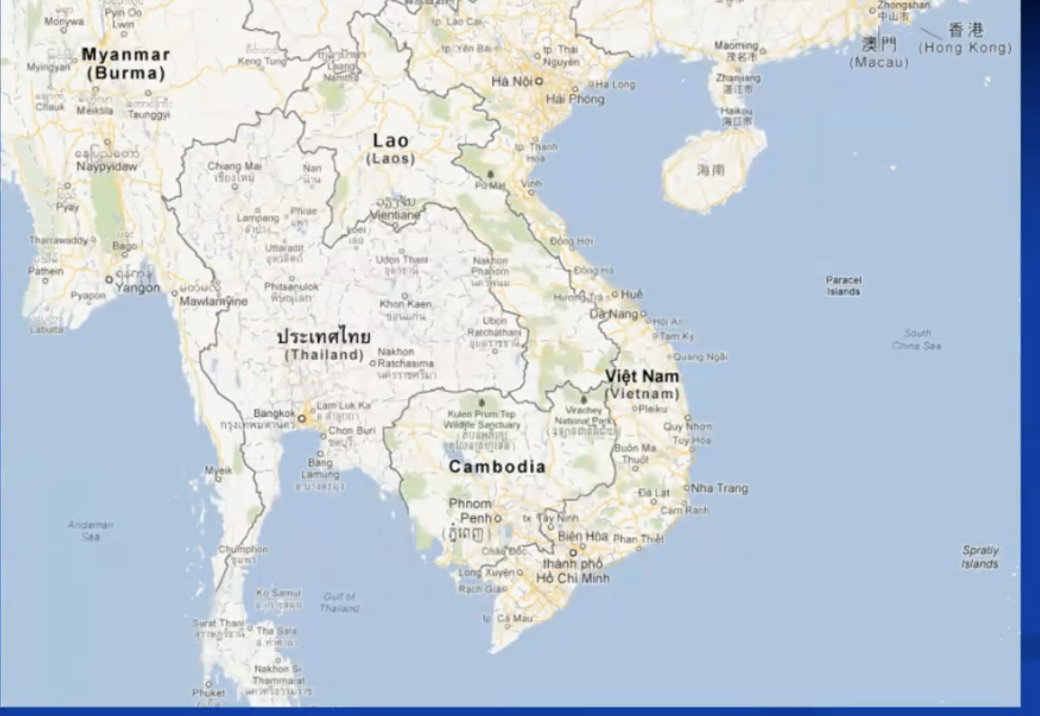
french interest in indo-china in 19th century
religion: many French missionaries
politics: competition with Britain
French: exclusion from india
continuous British expansion (India, straits, burma)
Napoleon III
trade: ‘faire de Saïgon un nouveau singapour’
gradual industrialization in France
—> need for new markets and resources
steppingstone to the newly opening chinese market
mekong river (via siam though) => start trade with china
tonkin and the red river
conquest of indochina by france
1860s and 1870s
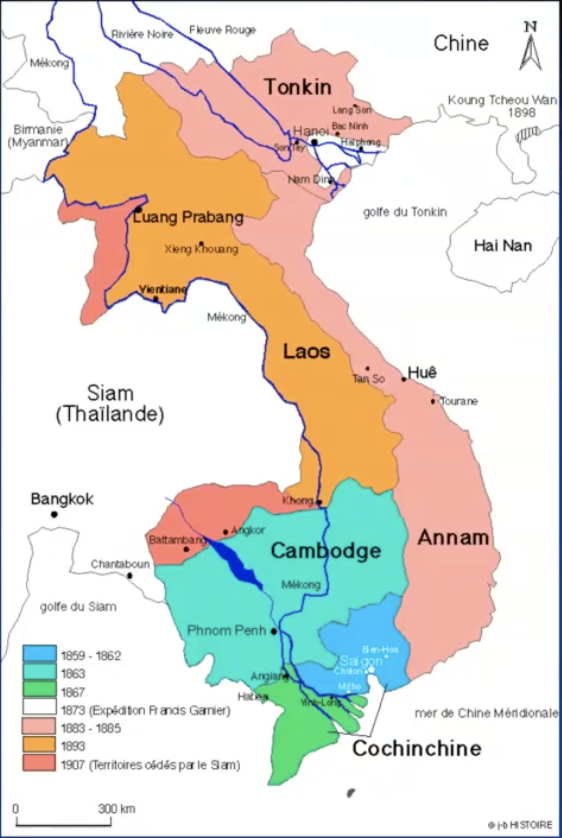
Siam
single non colonized country in south east asia
buffer between britain and france
competent kings (rama’s) = modernized kingdoms
took example of neighboring countries
use of western knowledge
Gustave Rolin-Jaequemyns: belgian who helped
siam king
but:
concedes territory
indirect colonization
turn of century: 95% of export in foreign hands
extraterritoriality & unequal treaties
1939: Siam —> thailand (‘land of the free’
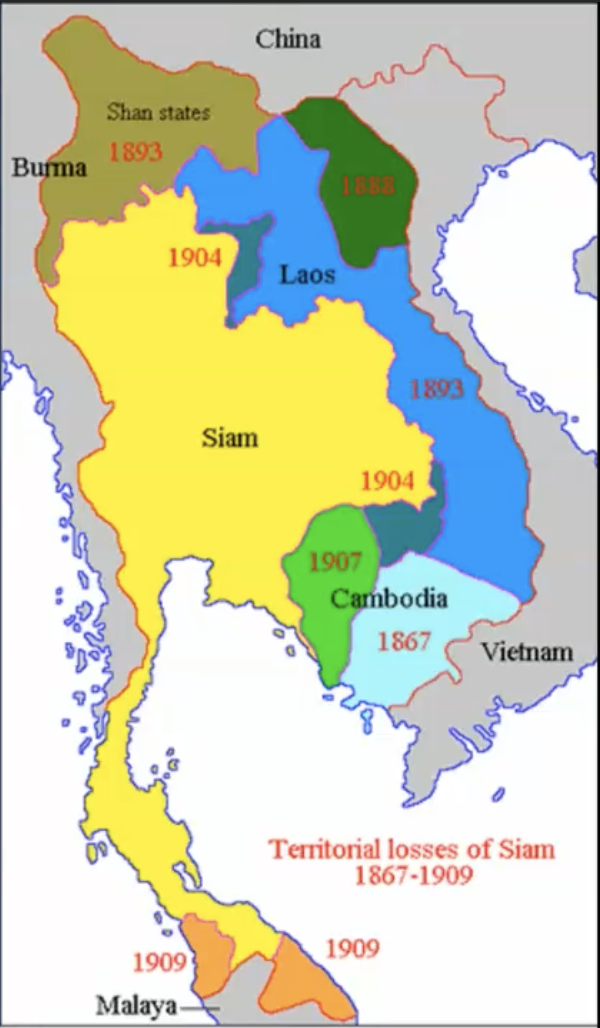
Ming dynasty
1368-1644
restoration of prestige
China power over korea, mongolia, siam, vietnam
tribute from japan, java, ceylon, east africa,…
contacts with europeans
traders (from 1514)
1557: portuguese (macau remained portuguese colony up until end of 20th century)
1622: dutch
missionaries
matteo ricci (1583-1610)
ferdinand verbiest (1659-1688)
Qing dynasty
successor ming dynasty: 1644-1911
last chinese dynasty = dynasty of decline
powerful in the 18th century: Kangxi and Qianlong
1759-1842 trade with europeans only via guild in canton (region of macau and later hong kong) on particular days
export of tea, silk and china; import of silver
tributary system (european traders had to pay respect to the emperor) and positive trade balance (exported more than they imported)
decline in the 19th century
white lotus rebellion 1796-1804 (blow to prestige of qing dynasty, image of unbeatable emperors scattered)
growing economic and technological backwardness
opium trade
europeans try to solve unequal trade balance = britain sells indian opium to china in order to pay trade
chinese trade balance turns negative
social consequences of opium use
first opium war
1839-1842
march 1839: chinese destroy opium ship in canton
british conquer canton, shanghai and nanjin
coincinding with first afghan war = british imperialism blooming in several places at the same time
brits defeat chinese => treaty of nanjing (1842)
no end to opium trade
hong kong british
five ports/concessions open for british trade
fixed and published rates and tariffs (europeans set the rules)
extraterritoriality: some districts of the cities were controlled by europeans
1844: also ‘unequal treaties’ with france and US
system of treaty ports (chinese cities were there were concessions and extraterritorialities, both sea ports and river ports all over china)
the second opium war
1856-1860
resistance in guangdong
1856: incident with arrow
british and french conquer canton and tianjin
1858/ treaty of tianjin [tientsin]
no restriction for christian missionaries
right to residence in beijing for western diplomats (embassies)
1859: representatives chased away
1860: french-british penal expedition in beijing
emperor deposed and summer palace destroyed
russians profit in far east
collaboration between chinese and europeans in 1860s
suppression taiping rebellion
1851: egalitarian, monotheistic and anti-manchu
20-30 million victims
1861-1864: westerners help in suppression
qing dynasty becomes ally/puppet of westerners
modernization of chinese society
language schools, industrialization,… = growing western presence
new tensions from 1870 onwards
london refuses modifications in treaty
anti-christian movement and ‘tientsin massacre’ (20 french missionaries and chinese christians killed)
colonization of chinese vasal states (burma, vietnam)
the rise of japan
tokugawa shogunate (1603-1867)
dynasty of shoguns
persecuted c atholic missionaries
restricted european merchants
1853-1854: US commander Matthew Perry
imposed trade concessions
civil war and meiji restoration (1867)
modernization and imperialism
1894-95: japan wins war with china
japan receives taiwan and liaodong (close to korea)
the partition of china
european reactions to japanese expansion
russia, germany and france: liaodong back to china
concessions for help to china
russia 1896: railway through manchuria (north-east china)
germany 1897: qingdao (now most famous chinese beer = german influence)
russia 1898: port arthur (Lüshun) on liaodong
jealousy of other states
britain: weihai (port edward) on shandong
also yangtze river under british influence
japan: fujian (opposite to taiwan)
france: guangzhouwan (north of french indochina)
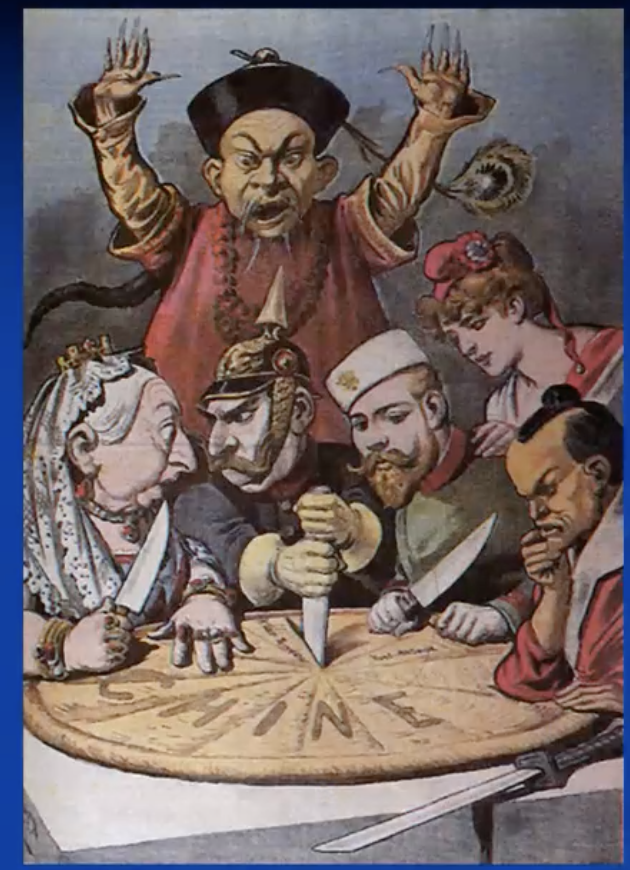
chinese reaction to partition of china
hundred days of western reform (june 1898)
sept 1898: queen dowager cixi confined emperor
boxer insurrection (1898-1900)
“the yellow peril”
started in shandong against chinese christians
quickly against all alien (railroads, mines,…)
supported by local authorities, later also by cixi
eight weeks’ siege of foreign embassies
august 1900: western penal expedition (eight-nation alliance) in beijing
russia and japan want to proceed dividing territory
US, Britain and France defend integrity chinese territory
changes imposed by the west in china
economic
industry: mines, railroads,…
trade: imposed tariffs
cutural
christian proselytism throughout china
western school system
territorial
whole areas annexed (as concessions) or in western influence
concession areas in cities (extraterritoriality)
free transit on waterways
military presence for protection
china in the early 20th century
dowager cixi launches reforms
abolishment of officials
1905 constitution and parliament
1908-12: emperor puyi (“the last emperor”)
1912-1916 Yuan Shikai (officer)
china falls apart (warrior lords)
kwo min tang (chinese nationalist party)
1912-1925 sun yat-sen: alliance with communists
chiang kai-shek: nationalist
mao zedong: communist
western presence in china
soviet union: growing influence
western states
conference of washington (1921-1922
eight countries recognize chinese territorial sovereignty
end of extra-territorial rights
1930: china controls its own tariff policy
1943: abolishment of the last unequal treaty
1997 (hong kong) and 1999 (macau) returned to china
japan (kept modernizing and growing and then attacked again)
1931 manchuria
1937 nanjing